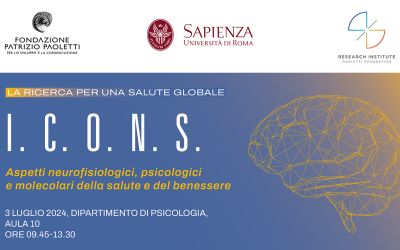
Il nuovo tecno-stress e “vecchie” dipendenze
Educarsi ed educare a gestire i rischi per la salute mentale
Dipendenze di diverso tipo costituiscono un fattore cruciale tra i fattori di rischio per la salute mentaleCosa si intende per salute mentale? Secondo l'Organizzazione... Leggi e l’educazione può fare una grande differenza nella nostra capacità di gestirle.
Secondo i dati più recenti dell’Istituto Superiore di Sanità, l’Italia presenta un quadro piuttosto allarmante per quanto riguarda il diffondersi di vecchie e nuove dipendenze, specialmente tra i più giovani. Secondo uno studio intitolato “Dipendenze comportamentali nella Generazione Z” presentato dall’Istituto Superiore di Sanità (ISS), oltre un milione e 150.000 adolescenti in Italia sono a rischio di dipendenza da cibo, quasi 500.000 potrebbero avere una dipendenza da videogiochi mentre quasi 100.000 presentano caratteristiche compatibili con la presenza di una dipendenza da Social Media, ed è diffuso anche il fenomeno dell’isolamento socialeL'isolamento sociale è un fenomeno psicologico e sociale ch... Leggi.
Le “vecchie” dipendenze
Così, per quanto riguarda l’abuso di alcool, i dati 2022 per l’Italia, sebbene negli ultimi anni si sia rilevata una tendenza alla riduzione dei consumi, l’alcool rimane la sostanza di cui più si fa uso durante l’adolescenza, con un picco fra i quindicenni. Al di sotto dei 15 anni, qualunque livello di consumo alcolico è da considerarsi a rischio, tra i 16 e i 18 anni 1 bicchiere di una qualsiasi bevanda alcolica è il livello massimo di consumo alcolico consentito secondo l’Organizzazione Mondiale della Salute. Inoltre, un comportamento definito rischioso è quello relativo all’abitudine di concentrare grandi quantità di alcol in un tempo limitato, pratica chiamata binge drinking.
Per quanto attiene alle sostanze psicotrope e gli stupefacenti, nel 2021, il 90,3% dei ragazzi ha assunto una sola sostanza illegale, il 6,1% ne ha assunte due e il 3,6% almeno tre; il 9,7%, pari a 44.000 studenti, viene definito nelle ricerche “poliutilizzatore”. I consumatori frequenti tornano ad aumentare di numero, dopo il calo del 2020.
Il tabagismo è un’altra dipendenza ben attestata tra gli adolescenti italiani. A partire dai 15 anni il 20% dei maschi e il 29% delle femmine riporta di aver fumato quotidianamente.
Le “nuove” dipendenze: il tecno-stress
Viene chiamato tecno-stress, quel tipo di impatto negativo, stressCos’è lo stress? Dal punto di vista clinico, lo stress è... Leggi diretto o indiretto, derivante dall’uso delle tecnologie, che influenza atteggiamenti, pensieri e comportamenti. Una delle “nuove” dipendenze di questo tipo dall’impatto particolarmente profondo sulla Generazione Z è la così detta social media addiction. Il 2,5%, circa 99.600 studenti, tra i partecipanti allo studio “Dipendenze comportamentali nella Generazione Z” presenta caratteristiche compatibili con una dipendenza da social media, percentuale che nel genere femminile raggiunge il 5,1% nelle studentesse di 14-17 anni. Lo stesso studio afferma che gli studenti a rischio nella popolazione 11-13 anni hanno 10,1 volte in più di probabilità di soffrire di ansiaL'ansia è una risposta emotiva caratterizzata da sentimenti... Leggi sociale grave o molto grave e 5,5 volte più probabilità di presentare un carattere ad alta impulsività.
Infine, l’Internet Gaming Disorder, ovvero il rischio di disturbo da uso di videogiochi vede coinvolto circa 480.000 studenti, il 12% dei partecipanti. La percentuale è più alta tra i maschi, con un 18% nelle secondarie di primo grado e un 13,8% tra gli studenti delle superiori. Rispetto all’età, la percentuale di rischio maggiore si rileva nelle scuole medie con il 14,3% dei ragazzi a rischio, mentre il dato scende al 10,2% alle superiori. I fattori associati sono la depressioneLa depressione è un disturbo caratterizzato da una tristezz... Leggi moderatamente grave o grave, e un’ansia sociale grave o molto grave.
Il nuovo webinar gratuito di Fondazione Patrizio Paoletti Salute digitale. Come gestire i rischi della dipendenza da web, nasce proprio per fornire a tutti i genitori, educatori e insegnanti idee e strumenti pratici per aiutarli a orientare figli e studenti verso un uso più consapevole delle tecnologie e del web.
Al di là delle forme, che si tratti di sostanze o comportamenti, e dei costumi legati ai tempi, le neuroscienzeIl cervello umano è una delle strutture più complesse e af... Leggi ci dicono che il nostro cervello interagisce con le diverse dipendenze in modo sempre molto simile.
SALUTE DIGITALE Come gestire i rischi della dipendenza da web
Compila il form
"*" indica i campi obbligatori
e guarda subito il webinar
Cosa le neuroscienze ci insegnano a proposito delle dipendenze
Dal punto di vista cerebrale, pressoché tutti i tipi di dipendenze condividono un meccanismo comune legato al così detto “sistema di ricompensaCon sistema di ricompensa, detto anche sistema della gratifi... Leggi”, detto anche “sistema della gratificazione”. Con questo termine si intende un insieme di strutture cerebrali responsabili della motivazioneLa motivazione: un punto di vista scientifico La motivazione... Leggi e dell’apprendimentoIl termine apprendimento - con i sinonimi imparare, assimila... Leggi dettato dall’esperienza. Le strutture cerebrali che costituiscono il sistema di ricompensa si trovano all’interno del circuito che include corteccia, gangli basali e talamo.
Il sistema di ricompensa funziona come un’interfaccia tra le strutture intermedie tra tronco encefalico e aree superiori, con le regioni frontali dove, secondo la forza dello stimolo ricevuto, una certa quantità dell’ormone dopaminaUn neurotrasmettitore che si trova nel cervello e nel sistem... Leggi viene rilasciata. Il rilascio di dopamina, detto anche ormone della felicitàLa felicità rappresenta uno stato emotivo caratterizzato da... Leggi, innesca il desiderio urgente di percepire un ulteriore stimolo. Il sistema dopaminico poi viene continuamente attivato fino a quando non si presenti l’effetto desiderato.
Il sistema di ricompensa è, quindi, alla base della possibilità di motivare un comportamento e guidare l’apprendimento ed è quindi indispensabile in ogni processo educativo, ma è anche alla base delle dipendenze da sostanze, la cui assunzione viene recepita come rinforzo. Un’educazione ben orientata sarà, dunque, quella che riconosce il meccanismo di ricompensa come parte del nostro funzionamento generale e consideri l’importanza della motivazione, ma anche la necessità di rimandare la gratificazione per non diventarne dipendenti.
La capacità di posticipare la gratificazione viene connessa in Pedagogia per il Terzo MillennioPedagogia per il Terzo Millennio (PTM) è un metodo interdis... Leggi ad una abilità bidirezionale della dimensione emotiva chiamata “resistere e arrendersi”.
“Resistere e arrendersi”: un passo doppio per cogliere l’opportunità della disciplina
Un esempio che illustra efficacemente l’educazione a resistere e arrendersi è quel del celebre “Esperimento dei marshmallow” dell’Università di Stanford. L’esperimento dei marshmallow di Stanford è stato uno studio sulla capacità di rimandare la gratificazione condotto dallo psicologo Walter Mischel nel 1972. Nello studio veniva offerta ad un bambino la possibilità di scegliere tra una piccola ricompensa subito o due piccole ricompense se avesse aspettato per un certo lasso di tempo. Il ricercatore lasciava poi il bambino in una stanza con un solo marshmallow per circa 15 minuti, quindi rientrava nella stanza.
Se il bambino non avesse mangiato il marshmallow, la ricompensa sarebbe stata un altro marshmallow o un pretzel, a scelta del bambino. I ricercatori hanno riscontrato negli anni successivi che i bambini in grado di aspettare più a lungo tendevano ad avere risultati migliori nella vita, misurati in base ai punteggi dei test di attitudine scolastica, al grado di istruzione, all’indice di massa corporea e ad altre misure di vita.
Per quanto i risultati del primo studio siano poi stati stemperati da altre ricerche, anche queste hanno confermato il dato che la capacità di autoconsapevolezzaIl termine autoconsapevolezza si riferisce primariamente all... Leggi e dominio di sé sono indicatori predittivi del benessere su più livelli.
PedagogiaLa pedagogia rappresenta un ponte tra le diverse discipline ... Leggi per il Terzo Millennio specifica che la capacità di dominare sé stessi si esprime attraverso un doppio moto emotivo che prevede contemporaneamente di poter resistere ad uno stimolo, arrendendosi ad una possibilità sentita come maggiormente significativa.
Crescere nell’eccellenza
Scrive Patrizio Paoletti in Crescere nell’eccellenza:
L’uomo è davvero capace di disciplina, è in grado di resistere, è in grado di arrendersi.
Resistere è quella funzione che consente di non essere fagocitati dalla voragine della recriminazione; occorre, infatti, capacità di resistere alle proprie paure, alle emozioni negative, all’auto-giudizio ad oltranza, quando, questo, non produce alcun frutto positivo; occorre resistere a quelle tendenze negative che vorrebbero prendere il sopravvento inquinando e distruggendo la visione positiva che l’umanità ha elaborato nel tempo.
Arrendersi è la funzione che consente ad ogni uomo di manifestare e raggiungere le proprie più intime aspirazioni. Occorre arrendersi all’evidenza dei fatti quando mostrano la necessità di chiedere aiuto, occorre arrendersi all’opportunità di essere disponibili e collaborativi, pronti e ricettivi, vitali e coinvolgenti per muoversi verso i tanti obiettivi agognati. Occorre arrendersi alla necessità della disciplina comprendendo che essa è fattore sinergico all’ottenimento di quella qualità di vita che ogni uomo desidera in sé raggiungere e manifestare.
- Mischel, Walter; Ebbesen, Ebbe B. (1970). “Attention in delay of gratification”. Journal of Personality and Social Psychology. 16 (2): 329–337. doi:10.1037/h0029815
- Paoletti, P. (2008) Crescere nell’eccellenza. Armando Editore.
- https://www.epicentro.iss.it/hbsc/pdf/temi2022/alcol-2022.pdf
- https://www.iss.it/documents/20126/825192/relazione-al-parlamento-2022.pdf/1eab04ab-579c-9584-8dae-799ae419a929?t=1657173847902
- https://www.epicentro.iss.it/hbsc/pdf/temi2022/fumo-2022.pdf
- https://www.iss.it/-/comunicato-stampa-n%C2%B023/2023-dal-cibo-ai-social-quasi-2-milioni-di-adolescenti-della-generazione-z-a-rischio-dipendenze-comportamentali
Sii parte del cambiamento. Condividere responsabilmente contenuti è un gesto che significa sostenibilità






